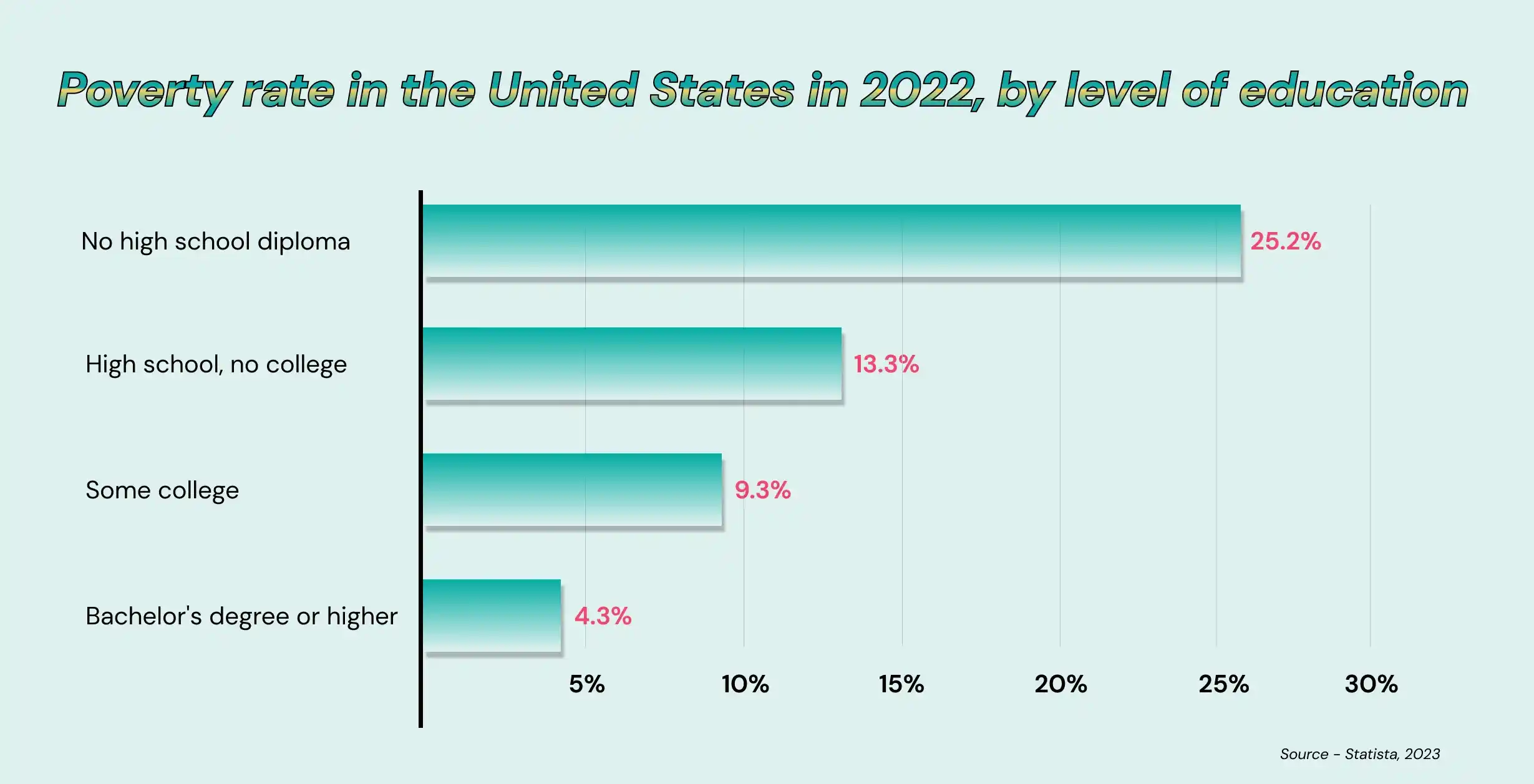“Education is the passport to the future, for tomorrow belongs to those who prepare for it today.” — Malcolm X.
From a young age, we are told the importance of post-secondary education. Young children widely believe that the better they learn, the brighter their future will be—but it’s also critical to understand the broader picture of education funding in the U.S., since national investment directly influences the availability and generosity of scholarships for low-income students. However, the golden truth about the undeniable importance of post-secondary education is often tested by life circumstances. For example, no matter how well young adults study, if they come from a poor family, they are more likely to be unable to pay for college, which is why bridging academic gap is such a problem these days. Scholarships can help offset the cost of a degree, offering critical financial relief to low-income students. However, it is also true that those who persevere will achieve what they want. For disadvantaged teenagers, there are scholarships for low income students. With their help, they can receive the degree they want and build the bright future teachers told them about at school.
Today, we will tell you about scholarships for low income children. If you are interested, read on to learn more.
Further in the article: |
Why Scholarships for Disadvantaged Students Are Important
The HealthCare.gov web portal contains data on the average income of families in poverty. The level of revenue differs depending on the number of family members and other significant factors. According to this data, the average annual earnings of a financially constrained household consisting of 3 people is $24,860. At the same time, the average cost of college in the United States is $36,436 per student per year, including books, supplies, and daily living expenses. Comparing these two figures, it is not difficult to understand what the main difficulty for students from poor families is.
As for other equally important problems, here are some of them:
- Limited choice of colleges. Financial constraints limit the pool of colleges to which a high school graduate can apply. This directly affects the ability to achieve career goals in the future. Scholarships for low income students can help to handle this problem.
- Restricted time for studying. The need to work part-time or even full-time to support oneself or one’s family has a detrimental effect on a young person’s academic performance. Scholarships for low income families may ease this load on a new student.
- Fear of debt. Although scholarships can relieve much of the financial burden, many students still confront understand the full scale of student debt in the U.S. Federal student loan programs, even with subsidized interest rates, can leave graduates with burdensome balances and long-term repayment plans.
If you’re balancing your studies while applying for scholarships, delegating academic tasks can help. Many students turn to professional services to write my coursework efficiently and maintain their academic performance.
Low income scholarships can help people from needy families get an education despite the many difficulties they are forced to overcome.
Federal Supplemental Educational Opportunity Grants and Other Valuable Governmental Funding Assistance Options
Being aware of the existing problem with financing higher education, the U.S. government offers young people from disadvantaged families several solutions to the problem. The first among them is the Federal Supplemental Educational Opportunity Grant (FSEOG). This is a program specifically designed to help undergraduate students with exceptional financial need. The provided funds can be used to cover tuition, fees, books, and other educational expenses. For more insight on deciding if a bachelor’s degree is worth the cost, check out this helpful resource.
Where to apply:
To apply for the FSEOG program, young adults must fill out the Free Application for Federal Student Aid (FAFSA). They can submit it online at the official website or by filling out a paper application.
Who is eligible for scholarships for low income students:
Full-time bachelor’s students with demonstrated hardship as determined by the FAFSA.
Amounts awarded:
Generally, FSEOG funding ranges from $100 to $4,000 per academic year.
Distribution of funds:
FSEOG grants go directly to participating colleges and universities. Each institution then transfers the money to the student’s account to support their educational expenses. Schools must make payments at least once per academic term (semester, trimester, or quarter).
Crafting a compelling application often includes writing a strong personal statement. Some colleges may require passing a more rigorous application process, like an SAT test. Well, we have gathered some strong, so you can choose a relevant issue for discussion in the writing section and get ready for the test in advance. Moreover, if you’re unsure how to make your application writing stand out, a personal statement help service can guide you through the process and improve your chances of success.
Please note that when determining eligible candidates for FSEOG, the authorities usually give preference to students with the lowest Expected Family Contribution (EFC).
Financial aid for low income students
Other possible state funding options for the education of young people from disadvantaged families include:
- Federal Pell Grant provides need-based aid to eligible undergraduate students. The amount of the grant depends on the Expected Family Contribution (EFC), which is calculated through the FAFSA.
- Federal work-study program encourages part-time employment of learners, which allows them to earn money to cover their education expenses.
- Federal student loans with reduced interest rates and flexible repayment terms from the US government can help needy teenagers pay for their college education.
Resources for low-income college students
In addition to paying tuition fees, a student from a poor family also has to handle other equally important problems that require significant funding. Disadvantaged learners can use the resources below to help meet their basic needs:
- Guidance and mentoring. The first place to look for help with studies is the educational institution’s tutoring or mentoring center. There, a low income student will be able to get the necessary advice and counseling for free. Alternatively, students can also visit StudentMentor.org, UStrive, and Mentoring.org web portals.
- Student housing. Many colleges offer special housing programs for people from low-income families. It is worth inquiring at the official representative office of the college or university about their availability. In addition, a teenager with financial difficulties should apply for the Section 8 housing federal program or search for reliable information on sites such as ModestNeeds.org.
- Dining services. Special meal plans at school cafeterias, college food pantries, or food banks can help students in financial constraints pay for meals. If necessary, a person can apply for the federal Supplemental Nutrition Assistance Program (SNAP). This way, they can receive low-cost food.
- Textbooks and school supplies. The surest way to save money on textbooks for school is to take them out of the library. Alternatively, a disadvantaged learner can use the portals CampusBooks.com or TextbookRentals.com.

Scholarships for Low Income College Students
Recognizing the difficult circumstances in which children from needy families live, various organizations are happy to lend a helping hand. Among the scholarships for low income college students, the following options can be highlighted:
- The Horatio Alger National Scholarship
The scholarship is one of the most generous options for funding educational expenses, with a total of $25,000. Established in honor of renowned author Horatio Alger, Jr., it provides assistance to 105 people each year. To receive scholarships for poor students, applicants must be high school graduates who are about to receive bachelor’s degrees and demonstrate financial need.
- The Hagan Scholarship
The main goal of the Hagan Scholarship Program is to meet the educational needs of low income college students. Participants in the initiative receive a staggering $60,000 to study in an eligible school. To qualify, applicants need to have a minimum 3.75 GPA and prove their need for funding.
- The QuestBridge College Match Scholarship
In addition to financial need, one of the most generous low income family scholarships requires an applicant to demonstrate strong academic achievement: being in the top 5-10% of the graduating class and having primarily A’s in challenging classes such as AP, IB, or honors. For such efforts, a student from a financially deprived family can expect to receive up to $200,000 in funding.
- The Davis-Putter Scholarship
A student can receive financial assistance in the amount of $15,000 by applying for a scholarship for low income college student. The applicant is required to be willing to study and further work on social and economic justice. Among other things, a disadvantaged child should prepare a completed FAFSA application, a good GPA report, two letters of recommendation, and a 1,000-word personal statement.
- The Dell Scholars
The organization is ready to help finance the education of a person from a poor family in the amount of $20,000. In order to receive funds from the scholarship for needy students, the applicant must have a minimum 2.4 GPA and a plan to enroll full-time in a bachelor’s degree program.
| HANDPICKED RELATED CONTENT: What Happens If You Plagiarize |
Grant for Low Income Students
The most promising opportunity to receive a grant for studying as a disadvantaged student is by applying for Federal Supplemental Educational Opportunity Grants (FSEOG), which were described in detail earlier in the article. As for other possible sources of funding in the form of grants, the following options are available:
- The Academic Competitiveness Grants (ACG) and Science and Math Access Grants for Retaining Talent (SMART) are for poor children studying in STEM fields. Students from low-income households with high GPAs are welcome to apply. Grant amounts range from $500 to $1,300 per year.
- How to help low income students? Students with financial need who have lost a father or mother due to military service are automatically eligible for the Iraq and Afghanistan Scholarship of $5,000.
Please remember that ACG is for first and second-year students, and SMART is for juniors and seniors.
Where Can These Grants Be Found?
There are many open resources to look for grants and full scholarships for low income students to support their college education. Here are just a few to mention:
- Federal Student Aid (FSA) website. The US Department of Education’s Federal Student Aid website is an important portal to begin the search for scholarships for low-income students.
- College web pages. Many colleges and universities provide information about scholarships and grants directly on their sites.
- Websites of non-profit organizations. Many non-profit organizations and foundations support students with grants and scholarships for the poor. Organizations such as Gates Millennium Scholars, the United Negro College Fund (UNCF), and the Hispanic Scholarship Fund offer a variety of opportunities.
- Online scholarship databases. Platforms Fastweb, Scholarship.com, and Appily.com are valuable resources for finding scholarship for needy students that fit individual circumstances.
Concluding Remarks on Low Income College Grants and Scholarships
It is not easy to make your way to a better life. This task is especially difficult for teenagers who grow up in needy families. Whether you prepare for or question the, staying away from higher education will lead you nowhere. As we mentioned at the beginning of the article, those who have a goal and are willing to work hard to achieve it will definitely succeed. There are many scholarships for low income students and grants available that can make obtaining a degree a realistic goal. Disadvantaged students should not neglect these opportunities but take full advantage of them. Of course, you will have to prove that you are the best candidate for the scholarship, and in most cases, you will have to complete a scholarship essay to present your candidature. If you are seeking help with this challenge, browse professionally written and learn in practice. Good luck!





